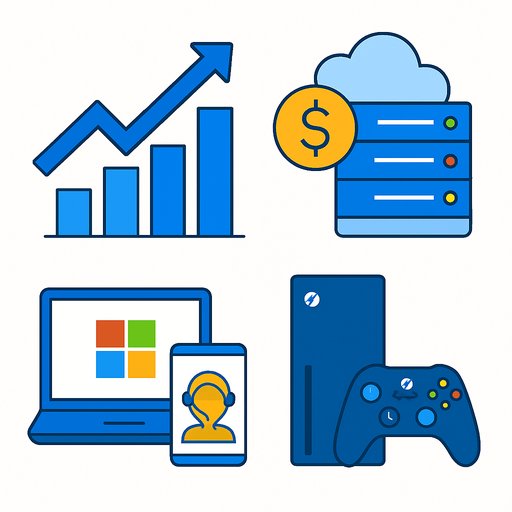Microsoft's Blockbuster October 2025: What Product Leaders Need to Ship Next
Microsoft spent October turning AI from a talking point into a capacity plan. The company pushed its stock near record highs, locked in massive compute, and shipped AI-first products while reorganizing leadership to move faster.
If you build products, the message is simple: plan for AI at scale, design for data residency, and expect compute bottlenecks to shape your roadmap more than feature ideas will.
Market signals: confidence meets execution
MSFT hovered around $514 by mid-October, within reach of its ~$555 peak. Up ~23% YoY and ~25% YTD, with 32 of 34 analysts rating it a Buy and average targets near $618. Some see a path to $5T in market cap as AI monetization expands.
Macro helped (cooling rates), but the story driving conviction is Azure growth and AI attach across the stack.
Compute is the new supply chain
Two big moves defined October:
- 5-year, $17.4B Nebius deal for 100k+ Nvidia GPUs (expandable to ~$19.4B). This is a hedge against GPU scarcity and a signal that even hyperscalers will rent capacity to meet AI demand.
- Consortium buyout of Aligned Data Centers (~$40B) alongside Nvidia and BlackRock to secure power, space, and cooling for AI workloads.
Product takeaway: treat GPU, power, and datacenter access as first-order constraints. Roadmaps should include multi-cloud options, workload portability, and model fallbacks (quantized, smaller, or distilled models) when premium GPUs aren't available.
New AI products that matter to builders
- Copilot+ Surface PCs and the first 5G Surface Laptop. On-device AI is here. Expect lower latency, offline features, and tighter security postures for sensitive workflows.
- Microsoft 365 Copilot + LSEG data: 33+ PB of market data now accessible via Copilot for finance use cases. This is a pattern you can copy: pair your product with proprietary, high-value datasets to create edge and lock-in.
- Local Copilot hosting in the UAE: region-first deployment model for data residency and compliance.
Product takeaway: plan dual paths-on-device inference for speed/privacy, and cloud inference for scale. Build region-aware data flows from day one. Your AI UX should degrade gracefully between local and cloud modes.
Leadership shift = faster platform moves
Judson Althoff is now CEO of Microsoft's commercial business (roughly 75% of revenue). Satya Nadella is leaning deeper into datacenter buildout, systems architecture, AI science, and product innovation.
Product takeaway: expect quicker platform changes (chips, clusters, APIs) and tighter sales-engineering loops. If you build on Azure, keep a close eye on new AI SKUs and procurement programs-they'll change cost curves mid-quarter.
Gaming goes premium (signal for pricing strategy)
Xbox teased a "very premium" next-gen console and launched a $999 handheld (effectively a mini Windows 11 PC). Microsoft also raised console prices and Game Pass fees, prompting backlash.
Product takeaway: premiumization can work for enthusiast segments, but expect churn and sentiment hits if value isn't clear. If you're moving upmarket, pair price hikes with unmistakable capability jumps and financing options.
Financial momentum and what to watch on Oct 29
Last quarter (Q4 FY25): revenue up 18% to $76.4B; Azure up ~34% YoY. For Q1 FY26, the Street looks for ~$75.5B revenue and ~$3.65 EPS. Capex is set to be ~<$span style="display:none;">30B for AI buildout, which may pressure margins near term.
Product takeaway: assume continued investment in AI infra and services. Your pricing, SLAs, and go-to-market can safely lean into more AI features in 2026 if usage trends hold.
Regulatory and platform realities
- EU accepted Teams unbundling from Office. Plan for more interoperability requirements across enterprise suites.
- U.S. class action challenges exclusivity around the OpenAI partnership; Microsoft disputes the claims. Expect ongoing scrutiny of AI platform deals.
- Windows 10 end-of-life hit Oct 14, 2025. One-year free ESU eases the transition, but your baseline should now be Windows 11 for support and AI feature parity.
What this means for product teams
Operational shifts to make this quarter
- Compute planning: create a GPU procurement plan with multi-cloud and spot capacity playbooks. Add model-switch logic (server, on-device NPU, smaller LLM) at the architecture level.
- Data residency by design: add a region selector to your AI data paths. Define which prompts, context, and outputs stay in-region. Document it for enterprise buyers.
- On-device AI UX: design fast, offline-first AI flows for sensitive actions (summarization, PII redaction, translation). Sync to cloud for heavier tasks.
- FinOps for AI: instrument per-feature inference costs. Set guardrails (max tokens, cache hits, batching, distillation) and ship a weekly "cost of intelligence" dashboard.
- Security and privacy: enable customer-managed keys, audit trails for prompts and responses, and red-team AI features for jailbreaks and data leaks.
- Interoperability: assume unbundling pressure. Ship open APIs, import/export, and easy swaps for chat, video, or docs if regulators force change.
- Windows baseline: treat Windows 11 as minimum for managed fleets. Map which AI features require it and update your device support matrix.
- Metrics: track "AI attach rate" (users who use at least one AI feature weekly), "time saved per task," and "support tickets per 1k AI sessions." Tie them to pricing and renewal arguments.
Go-to-market playbook
- Package value clearly: if introducing AI surcharges, show measurable outcomes (time saved, error reduction, conversion lift) before asking for more money.
- Segment pricing: keep an accessible tier while testing premium performance tiers for power users.
- Land enterprise trust: lead with data residency, auditability, and model choice. Offer customer isolation for prompts and embeddings.
Build vs. buy: practical calls
- Buy foundational LLMs and vector infra; build domain adapters, retrieval layers, and UX loops.
- Keep an "LLM abstraction" so you can switch between Azure OpenAI, other clouds, or on-device models without major rewrites.
- Cache aggressively. Fine-tune or distill only where usage is high and unit economics justify it.
Risks to price into your plans
- GPU scarcity: capacity spikes around big launches and end-of-quarter rushes. Ship fallback paths and queueing.
- Cost overrun: prompt creep is real. Cap tokens, throttle non-critical jobs, and batch server-side evaluations.
- Regulatory whiplash: be ready to unbundle, switch vendors, and add export features on short notice.
- User backlash to pricing: if you're going premium, deliver visible speed and capability gains. Offer trials and flexible billing.
Signals to watch next
- Microsoft earnings (Oct 29): Azure growth trajectory, Copilot monetization, and capex/margin guidance.
- AI infra updates: new Blackwell-class clusters on Azure and regional expansions that change latency and cost for your users.
- Data partnerships: more "Copilot + proprietary data" plays across industries-opportunities to embed your product into daily workflows.
Upskill your team
If your org is moving to on-device + cloud AI, strong internal skills will save months of trial and error. Curated, role-based training helps teams ship usable features faster.
Bottom line
Microsoft is locking in compute, shipping AI-first hardware and software, and resetting expectations for enterprise-grade AI. As a product leader, your edge comes from treating compute, data residency, and AI economics as core product problems-not afterthoughts.
Plan for scarcity, build for choice, and price on outcomes. That's how you'll keep shipping while the platform keeps moving.
Your membership also unlocks:






